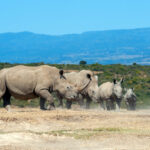Introduction
Stretching across the vast plains of northern Tanzania, the Serengeti is one of the most iconic wildlife destinations in the world. Known for its breathtaking landscapes, abundant wildlife, and the awe-inspiring Great Migration, it offers a safari experience like no other. Every year, millions of wildebeest, zebras, and gazelles traverse the plains in search of fresh grazing lands, creating one of nature’s most remarkable spectacles. But the Serengeti is more than just a migration hotspot—it’s a year-round paradise for wildlife enthusiasts, photographers, and adventurers alike.
This article takes you through what makes Serengeti tours so extraordinary, from the thrill of spotting predators in action to the quiet beauty of an African sunset.
The Magic of the Great Migration
The Great Migration is often called the “world cup of wildlife,” a massive and continuous movement of over 1.5 million wildebeest, accompanied by hundreds of thousands of zebras and other herbivores. The cycle begins in the southern Serengeti, where calving season takes place between January and March. Here, thousands of newborn calves are welcomed into the world—an event that draws predators like lions, cheetahs, and hyenas to the area.
As the dry season approaches, the herds begin their northward journey toward the Mara River, where dramatic river crossings take place. This is arguably the most thrilling part of the migration, as animals plunge into crocodile-filled waters, driven by instinct and survival. It’s a raw, emotional display of nature at its most intense.
Beyond the Migration: Year-Round Wildlife Viewing
While the Great Migration is a major highlight, Serengeti tours offer much more than this seasonal event. The park is home to the famous “Big Five” — lions, elephants, buffalo, leopards, and rhinoceroses — as well as over 500 bird species. From towering giraffes grazing acacia trees to stealthy cheetahs sprinting across the plains, every game drive is filled with unexpected encounters.
The central Serengeti is a predator hotspot, with a high density of lions and leopards. The western corridor is lush and perfect for hippo sightings, while the northern reaches are quieter and less crowded, ideal for travelers seeking a more exclusive safari experience. No matter where you go, the Serengeti’s diverse landscapes—from golden grasslands to rocky outcrops called kopjes—provide breathtaking backdrops for every photograph.
Immersive Safari Experiences
For travelers seeking an immersive adventure, Serengeti tours can be tailored to suit different travel styles. Luxury lodges offer comfortable stays with sweeping views of the plains, while mobile tented camps allow you to follow the migration’s path for a more intimate experience. Hot air balloon safaris are another popular choice, giving you a bird’s-eye view of the sunrise over the endless savannah, followed by a champagne breakfast in the wild.
Night game drives, available in certain areas, offer a completely different perspective—revealing nocturnal creatures such as bush babies, aardvarks, and servals. Cultural visits to nearby Maasai villages add a human touch to the journey, allowing you to learn about the traditions and history of this proud, semi-nomadic community.
When to Visit the Serengeti
The Serengeti is a year-round destination, but the timing of your visit will depend on what you want to see.
- January to March: Calving season in the southern Serengeti; excellent predator activity.
- April to June: Herds move toward the western corridor; fewer tourists and lush scenery.
- July to September: Dramatic Mara River crossings in the north; prime Great Migration viewing.
- October to December: Herds return south; good general wildlife viewing with warm weather.
Even outside migration periods, the Serengeti teems with wildlife, so every month offers incredible safari opportunities.
Planning Your Serengeti Adventure
When booking serengeti national park tours, it’s important to choose a reputable operator who understands the migration patterns and can customize your itinerary. A knowledgeable guide can make all the difference in spotting elusive species and explaining animal behaviors. Decide whether you want a private safari for a more personal experience or a group tour for a social, budget-friendly option.
Consider combining your Serengeti adventure with other destinations, such as Ngorongoro Crater, Tarangire National Park, or the beaches of Zanzibar, for a diverse Tanzanian holiday.
Responsible Travel and Conservation
Tourism plays a crucial role in funding conservation projects that protect the Serengeti’s fragile ecosystem. By choosing eco-friendly lodges, following park rules, and minimizing waste, travelers can help preserve the park for future generations. Supporting local communities through cultural tourism and purchasing locally made crafts also contributes to the region’s economic sustainability.
The Lasting Impact of a Serengeti Tour
A journey to the Serengeti isn’t just about seeing animals—it’s about connecting with nature in its purest form. The sight of an endless horizon under a golden African sun, the sound of lions roaring in the distance, and the sheer scale of the migration are moments that stay etched in memory. Many travelers describe it as a humbling, life-changing experience that deepens their appreciation for the natural world.
Whether it’s your first safari or a return visit, serengeti national park tours offer something magical every time. From thrilling wildlife encounters to serene moments under star-filled skies, the Serengeti captures the essence of the wild in a way few places can.
Conclusion
The Serengeti is more than just a destination—it’s a living, breathing masterpiece of nature. The Great Migration may be the star attraction, but the park’s year-round wildlife, stunning scenery, and rich cultural heritage ensure that every tour is unforgettable. By witnessing the Serengeti firsthand, you become part of its story, contributing to its protection and preservation.
If you’ve ever dreamed of an authentic African safari, let the Serengeti be your stage—where every day brings a new chapter, and every moment is a reminder of the wild’s enduring beauty.
